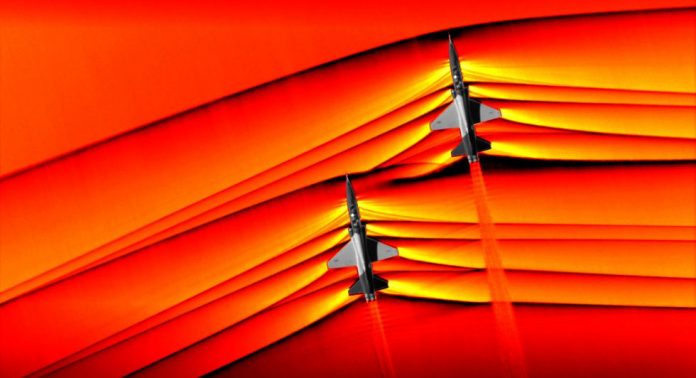NASA’s mission to capture air-to-air images of supersonic shock waves was a long and fraught process that lasted more a decade. But now, the space agency has accomplished the task with flying colors.
On Tuesday, NASA released a series of stunning images that show two T-38 supersonic jetliners tearing through the atmosphere, creating sonic shock waves. The images were made possible by a NASA B-200 King Air aircraft, which ferried an updated camera imaging system up to 30,000 feet. At altitude, it followed the jets from a distance of 2,000 feet, snapping their trek through the sound barrier at 1,400 frames per second.
“I AM ECSTATIC ABOUT HOW THESE IMAGES TURNED OUT”
The T-38s flew in tight formation, separated only by 10 feet. Documenting their burst through the sound barrier from such a close vantage point will help NASA accrue more data on supersonic shock waves than ever before, which is a pressing matter given the potential resurrection of supersonic passenger travel.
“I am ecstatic about how these images turned out,” J.T. Heineck, a researcher at NASA’s Ames Research Center said in a press statement.“With this upgraded system, we have, by an order of magnitude, improved both the speed and quality of our imagery from previous research.”
Shock waves are created by aircraft flying faster than the speed of sound. When these waves merge, they create a loud bang in the form of a sonic boom. NASA hopes its research will inform plans for its quiet supersonic plane, the X-59 QueSST, which is slated for test flights in 2022. The new data points could allow scientists to refine the X-59 so that it’ll resound with only a faint noise when it crashes through the sound barrier.
If successful, the project could help the nascent supersonic airliner revival gain traction: The most famous commercial supersonic plane, the Concorde, was permitted to break the sound barrier only when it was out over the ocean because of the sonic boom problem. But if the quieter technology employed by the X-59 proves viable, it could help bring supersonic airliners back from extinction.








